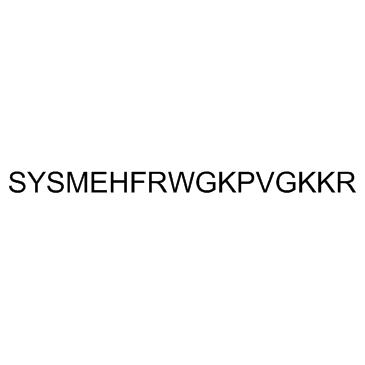7266-47-9
| Name | Adrenocorticotropic Hormone Fragment 1-17 human, rat |
|---|---|
| Synonyms |
ACTH (1-17)
alpha1-17-Corticotropin alpha1-17-ACTH SYSMEHFRWGKPVGKKR |
| Description | ACTH (1-17), an adrenocorticotropin analogue, is a potent human melanocortin 1 (MC1) receptor agonist with a Ki of 0.21 nM. |
|---|---|
| Related Catalog | |
| Target |
Ki: 0.21 nM (human MC1 receptor)[1] |
| In Vitro | ACTH (1-17) is a potent agonist at the hMC1R. ACTH (1-17) shows high affinity for the hMC1R with a Ki value of 0.21±0.03 nM which is slightly higher than that of 0.13±0.005 nM for alpha-MSH[1]. ACTH (1-17) induces a slight and not significant increase in growth hormone secretion even when micromolar concentrations of the peptide are employed in rat pituitary cultures[2]. |
| In Vivo | Inhibition of DNA labeling is noted when the ACTH (1-17) is administered at 2 hr after the beginning of the daily dark span when nocturnal animals become active. When administered at this circadian stage, the larger dose in particular is associated with an inhibition of DNA labeling lasting for 24 hr. The inhibitory effect is much shorter when the same dose is injected 4 hr earlier[3]. |
| Cell Assay | Rat pituitary cells are incubated in the presence of varying concentrations of ACTH (1-17) (0.1 nM-1 μM). A significant increase of growth hormone secretion is documented with each concentration[1]. |
| Animal Admin | Mice[3] The effects of ACTH (1-17) on the rate of DNA labeling in the metaphyseal bone of CD2F1 mice are tested on a chronopharmacological dosing schedule. Groups of mice that has been conditioned to a 12-hr light/12-hr dark schedule are injected at one of six different timepoints, 4 hr apart during ,a single 24-hr span with either a low (0.021 I.U/kg) or a high (20 I.U./kg) dose of ACTH (1-17). Control groups receive injections of a placebo at corresponding timepoints. Subgroups of mice are injected with [3H]thymidine ([3H]Tdr) to follow the changes in DNA labeling in the proximal tibial metaphysis at 15 min and 2, 4, 8, 12 and 24 hr after ACTH (1-17) or placebo treatment[3]. |
| References |
| Molecular Formula | C95H145N29O23S |
|---|---|
| Molecular Weight | 2093.41000 |
| Exact Mass | 2092.08000 |
| PSA | 889.75000 |
| LogP | 3.96140 |
| Index of Refraction | 1.685 |
| Storage condition | -20°C |
| Personal Protective Equipment | Eyeshields;Gloves;type N95 (US);type P1 (EN143) respirator filter |
|---|---|
| RIDADR | NONH for all modes of transport |
| WGK Germany | 3.0 |
